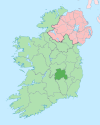Rathdowney
History
Rathdowney is named after a nearby ringfort, or ráth, which was levelled in 1830. This ráth is mentioned three times in the Annals of the Four Masters:
- 874 Flaithri, son of Máel Dúin, Lord of Rath-Tamhnaighe (Rathdowney) died
- 909 Maelpadraig, son of Flaithri, Lord of Rath-Tamhnaighe, died
- 1069 Gillamoula, grandson of Bruaideadh, Lord of Rath-Tamhnaighe
The settlement of Rathdowney has existed since at least the 9th century. Historically it forms part of the Kingdom of Osraige, and today it remains part of the Roman Catholic Diocese of Ossory, as such Rathdowney is not historically part of Laois. The present-day county of Laois is a modern administrative construct. A half mile southeast of Rathdowney, there stood until 1836, the ruins of a castle called Rathpiper, which most probably took its name from "Pipard", a descendant of Adam de Hereford. This locality of "Pyperath" within Rathdowny parish appears to have been a royal site associated with the medieval Mac Giolla Phádraig dynasty, as documents relating to meeting there in 1558 show.
The Croppy's Grave located in the town's central square is the still visible cobbled grave of a croppy revolutionary hanged and buried there in 1798. The site also contains a recent memorial.
The town was raided at least once by anti-treaty forces during the Irish Civil War of 1922 to 1923.
Queen Victoria passed through Rathdowney during her first visit to Ireland in 1849 and in a letter to her maternal sibling Princess Feodora of Leiningen about the visit to Ireland she described passing through a town assumed to be Rathdowney by historians as "a quaint village, surrounded by hills" and went on to describe it as "an idyllic small town".

Churches
Saint Andrew's Church of Ireland church, which overlooks the town's square, was built in the early 19th century. It stands on the traditional site of the pre-Reformation church. A Roman Catholic church was constructed on the main street in the 1830s, and this church served the Catholic population of the area for the next 120 years before it too was demolished; to be replaced by a shrine and carpark. A new larger Catholic church, the Church of the Holy Trinity, was designed by Simon Aloysius Leonard and built on the west side of the town in the 1950s.
There are a number of "mass pits" (outdoor areas used for Catholic masses during penal times) located in the vicinity of the town.
Economy
The Meadow Meats processing plant is part of the Dawn Meats Group and was the largest employer in the town. This factory stands on the old Perry's Brewery site, it was purchased by Lyons Meats in 1968 and converted by them to a meat processing facility, which went into production in 1971. Rathdowney is also something of a centre for several out lying villages and is a focal point for the surrounding agricultural hinterland.
People
- Tony Byrne, international footballer.
- Ned Campion, international showjumper.
- Kieran Patrick Kelly, suspected serial killer.
- Edward Ledwich, historian, antiquary and topographer, was curate in Rathdowney for a time.
- John Moyney, an Irish recipient of the Victoria Cross, was born in Rathdowney.
- James Pearson, also a Victoria Cross recipient from Rathdowney.
- Kieran Phelan, Irish politician, member of Seanad 2002–2010.
- Thomas Prior, author and founder of the Royal Dublin Society.
See also
References
- ^ "Sapmap Area - Settlements - Rathdowney". Census 2016. Central Statistics Office. April 2016. Retrieved 28 January 2020.
- ^ "Ráth Domhnaigh / Rathdowney". Irish Placenames Commission. Retrieved 28 January 2020.
- ^ Carrigan, William (1981). The History and Antiquities of the Diocese of Ossory. ISBN 9785879206463.
- ^ Fitzpatrick, Elizabeth (2004). Royal Inauguration in Gaelic Ireland C. 1100-1600: A Cultural Landscape Study. ISBN 9781843830900.
- ^ "Rathdowney Church Of Ireland Church, Rathdowney, County Laois". buildingsofireland.ie. National Inventory of Architectural Heritage. Retrieved 28 January 2020.
- ^ "Co. Laois, Rathdowney, Church (RC)". Dictionary of Irish Architects. Irish Architectural Archive. Retrieved 28 January 2020.
